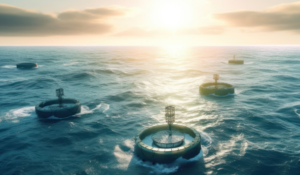Tidal Turbines: How the Ocean’s Tides Help in Powering a Sustainable Future
Tidal turbines are joining the front lines of the fight against climate change. This perpetually advancing way to harness ocean tides provides a renewable energy source for cleaner electricity for future generations. In a world seeking sustainable solutions, it is tidal energy that proves very reliable and displays great potential for reduced carbon emissions.
Although technologies have improved, they still face challenges. Issues like installation costs and environmental impacts are some of the concerns that need to be addressed so that tidal energy is more viable. With the continuous innovations, the future for tidal turbines is bright because it ensures that they become vital in energy production.
Key Points
- Tidal turbines indeed represent a real and reliable source of renewable energy.
- The challenges do exist but the progress of innovations also does.
- Tidal energy can contribute to reduction dependence on the use of fossil fuel.
Harnessing Tidal Energy
Tidal energy is a resource derived from the natural rise and fall of sea levels, a result of gravitational influences by both the moon and sun. The section looks at principles of tidal power, types of turbines to harness it, and advantages realized from this renewable energy source.
Principles of Tidal Power
Tidal power works by harnessing energy from the movement of water. In this regard, rising and falling tides can create strong currents that can, in turn, be converted into electricity. The principle here is the conversion of kinetic and potential energy developed in moving water to usable energy.
This is attained through the construction of structures like dams or tidal barrages. The structures are capable of allowing water to flow through turbines. When water flows, it turns the turbines to generate electricity. The energy generated is predictable and reliable since tides are in a constant cycle.
Types of Tidal Turbines
There are many types of tidal turbines in application in harnessing tidal energy. Some of the major types include:
- Tidal Stream Turbines: These are the aquatic equivalent of wind turbines. They work on the principle of moving water in currents to create electricity.
- Tidal Barrages: These are huge dams constructed across the estuary. In their working process, water gets trapped at high tide and is released at low tide through turbines.
- Tidal Kites: Much smaller devices that remain anchored at the bottom of the ocean, they move with the current and can be much more efficient at producing energy from various locations.
Each of the types that exist has advantages in particular locations and conditions of the flow of water.
Advantages of Tidal Energy
As with each source of energy, so does tidal energy have a number of advantages. It is renewable and does not emit greenhouse gas during operation. This makes it an environment-friendly alternative to fossil fuel.
Tidal energy can be predicted to a great extent. Unlike wind or solar power, tidal movements can be forecasted to the total accuracy. This therefore allows for good planning and integration in the energy system.
Moreover, tidal power does not affect the environment much. Most of the technologies can coexist with marine life, hence making it a sustainable option. While technology improves, the costs might go down and tidal energy more accessible.
Challenges and Innovations
There are a number of challenges that tidal turbines face in regard to their development and deployment. These include impacts on the environment, technological challenges, and economic factors. Innovation is greatly needed in these fields if the future of tidal energy is to be realized.
Environmental Impact
Tidal turbines do have effects on marine ecosystems. The placement of the turbines within any body of water will disrupt the native wildlife, mainly fish and marine mammals.
Key issues of concern:
- Habitat alteration: Generally affects the natural habitat of the species.
- Noise pollution: The noise generated by these turbines interferes with sensitive marine species.
- Sediment movement: Turbine Blades alter sediment flows, which might impact sea floor plants and organism growth.
For these reasons, developers must conduct comprehensive environmental impact studies. Researchers are designing turbines to do minimal damage, such as using slower-moving blades that would kill fewer birds.
Technological Challenges
There are quite a few technical difficulties to making truly viable tidal turbines.
Some of the most significant technological obstacles to tidal turbines:
- Durability: Turbines will need to be able to survive under harsh ocean conditions, such as extreme currents and saltwater corrosion.
- Energy efficiency: There is still much room for improvement in the conversion of energy. Developers are experimenting with novel materials and new design features to enhance efficiency.
Tidal Energy: Challenges
- Maintenance: The mechanism of underwater turbines is difficult to reach for maintenance purposes. Innovations in the self-repair and remote monitoring are likely to overcome the situation.
Development of Turbomachinery has to be done so that the system of tidal energy conversion becomes more reliable and efficient.
Economic Issues
Projects for tidal energy may be expensive to construct. Key factors influencing project economics include:
- Investment: Construction of tidal energy facilities requires high investment.
- Long-term profitability: Investors need to have assurances of long-term profitability of such projects.
Market Competition: Tidal energy is in competition with other forms of renewable energy. To be able to perform well in the market, there is a dire need for price competitiveness.
Partnerships by governments and private sectors will contribute to improving economics. Incentives, subsidies, and innovative funding strategies could be other ways to encourage investment.

Also Read :
- From Waste to Watts: Transforming Biomass into Renewable Energy
- Harnessing the Power of the Wind: Future Innovations in Wind Energy
- From Fossil Fuels to Renewables: The Transition to a Clean Energy Future
- Breaking Down the Basics: How Renewable Energy Works
- MRI Safety: What You Need to Know Before Your Scan
